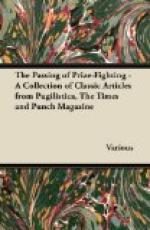As to china, what the Duffer buys is invariably cracked, and the “marks” on which he places confidence are flagrant imitations. He usually begins by supposing that Crown Derby is a priceless possession, also he has a touching faith in chipped blue and white cups and saucers, marked with a crescent. Worcester they may be, but not the right sort of Worcester. And Crown Derby is the very Aldine or Elzevir of this market. You might as well collect shares in the Great Montezuma Gold Mine, and expect to derive benefit from the investment.
Gems are among the things that the Duffer may most wisely collect, for the excellent reason that, in this country, he very seldom indeed finds any for sale. He cannot come to much sorrow, for lack of opportunities. In Italy it is different. How many beautiful works of Art I have acquired in Florence, at considerable ransoms, all of them signed in neat, but illegible Greek capitals. I puzzled over them with microscopes. The names seemed to end in [Greek: ICHLES]. I thought myself a rival of BLACAS, or Lord KILSYTH, or the British Museum. Then my friend, WILKINS, came in. “Pretty enough pastes of the last century I see,” he remarks. “Pastes!—last century!” I indignantly exclaim; “why they’re of the best period: Sards, all of them signed, but I can’t make out the artist’s name.” “It is PICHLER,” says WILKINS, “he usually signed, for fear his things should be sold as antiques.” I had to give in about PICHLER (which certainly does not sound very Greek); “but here,” I said, “you can’t call this paste, you can’t scratch the back of it.” “I know I can’t,” says WILKINS, examining the ring, “for a very good reason, because a thin layer of sard has been inserted behind. But it’s paste, for all that.”
“Well,” I say, “here’s a genuine ancient ring, old gold, and a lovely head of Prosperine in cornelian.”
“Well, this is odd,” says WILKINS, “I know the setting is genuine, I have seen it before. But then it had a rubbishy late bit of work in it, and I was in the atelier when a gem-cutter shaved away the top of the stone, and copied your head of Prosperine on it from a Sicilian coin. I can show you a coin of the same stamp in my collection.”
[Illustration: “HER MAJESTY’S SERVANTS.”
VIEW OF THE STAGE ON THE RE-OPENING OF THE THEATRE ROYAL WESTMINSTER.]
And he showed me it, otherwise I might have remained incredulous. “These scarabs,” he went on, “are from Birmingham, I know the glaze. That gold Egyptian ring, Queen TAIA’s do you say, is Coptic, Cairo is full of them. That head of CAESAR is a copy from the one in the British Museum.”
“Why, it is rough with age,” I said.
“Ay, they’ve stuffed it down a turkey’s crop, and it has got rubbed up in the gravel with which the ingenious bird assists the process of digestion. A man who could swallow that gem is a goose.”
I am presenting my esteemed collection of ancient engraved stones to my nephew at school, who shows all the character of the collector. He may swop them for bats, or tarts, or he may learn wisdom from the misfortunes of his uncle.




